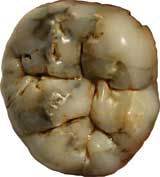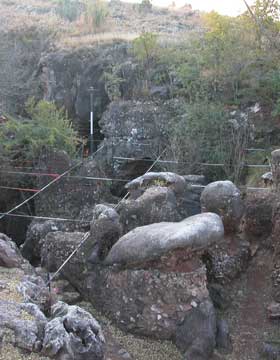|
News Notes
Human evolution
Hominid teeth reveal a broad palate
 |
| About 2.5 million years ago, several species of early hominids lived in the African savanna. Previously, researchers had suggested that one species died out due to climate change and a lack of a varied diet, but new research on the hominid’s teeth (above), found in the Swartkrans province of South Africa, pictured below, is changing that idea. Images are courtesy of Matthew Sponheimer. |
 |
The early hominid Paranthropus robustus may have lost out to various species in the genus Homo in the evolutionary path that gave way to modern humans, but the species’ failure can’t be blamed on picky eating. Researchers have theorized that P. robustus died out because its inflexible eating habits left it unable to cope with a changing climate in the African savanna. But a new study, which examines chemicals left in fossilized teeth, indicates that P. robustus had a much more expansive diet than previously believed.
About 2.5 million years ago the family tree headed by australopithecines — the group that included the famous fossil dubbed “Lucy” — split into two genuses: Paranthropus, which subsequently died out roughly a million years later, and Homo, the successful group that gave rise to modern humans.
For about 1 million years, P. robustus coexisted with several Homo species in a tropical environment containing a variety of plant life. Yet researchers had long thought that the diminutive and small-brained P. robustus only incorporated a small portion of the biodiversity in their diets.
The species had massive teeth and muscles in their jaws and have been “characterized as chewing machines of a sort,” says Matthew Sponheimer, an anthropologist at the University of Colorado at Boulder and lead author of the study. Their morphology gave every indication that they subsisted mainly on hard foods like nuts and seeds that required a lot of effort to break down. Sponheimer notes, however, that dental morphology reveals more about the challenges faced by an animal’s ancestors than those experienced by the animal itself.
Wanting to get at the specifics of the diet of the “failed humans,” Sponheimer and colleagues took a closer look at 1.8-million-year-old fossil teeth from four P. robustus individuals found in the Swartkrans province of South Africa. Teeth grow in layers, “roughly analogous to tree rings,” Sponheimer says, and the carbon from foods an animal eats becomes trapped within the layers of enamel.
A technique called laser ablation allowed Sponheimer’s team to drill out one tiny layer of tooth enamel at a time — about a week’s worth of growth. The researchers then used stable isotope analysis to identify the kinds of carbon present in the two layers. One isotopic signal corresponds to a group of plants that includes trees and shrubs. The other reflects the consumption of plants such as grasses and sedges.
The results contradicted the hominid’s reputation for choosy eating, Sponheimer says. Intake of one type of plants varied by as much as 40 percent in a single individual, the researchers reported in the Nov. 10 Science.
Analyzing different tooth layers confirmed that individuals varied their diets from season to season and year to year. In one tooth the variation was extreme, showing a switch “from almost pure grasses to something much more like a typical primate, all seeds or fruit,” Sponheimer says. Such a “really dramatic” dietary switch, he says, has rarely, if ever, been seen.
The food switches suggest an ability to survive even if droughts or climate change eliminated the foods the hominids normally ate, Sponheimer says. The variation could also reflect a migratory lifestyle, which would have exposed them to multiple habitats.
Still, P. robustus’ broad palate did not prevent it from going extinct, leaving researchers no closer to figuring out why the species disappeared. Sponheimer says one possible explanation is that the Homo species “simply outbred them.” Homo’s quick breeding combined with its use of tools may have left P. robustus unable to compete evolutionarily.
Studying tooth enamel might be a way for researchers to gain further insight into this intergenus competition, says Stanley Ambrose, an archaeologist at the University of Illinois at Urbana-Champaign (see Geotimes, October 2005).
“The degree to which diets overlapped might have been an important variable to understanding how much competition there may have been for community resources,” he says. And Peter Ungar, an anthropologist at the University of Arkansas, agrees that laser ablation could revolutionize archaeological study. “The new technology has allowed us to ask questions that nobody would have even contemplated asking before.”
Katherine Unger
Geotimes contributing writer
Links:
"Ancient teeth tell diet secrets," Geotimes, October 2005

 Subscribe
Subscribe

